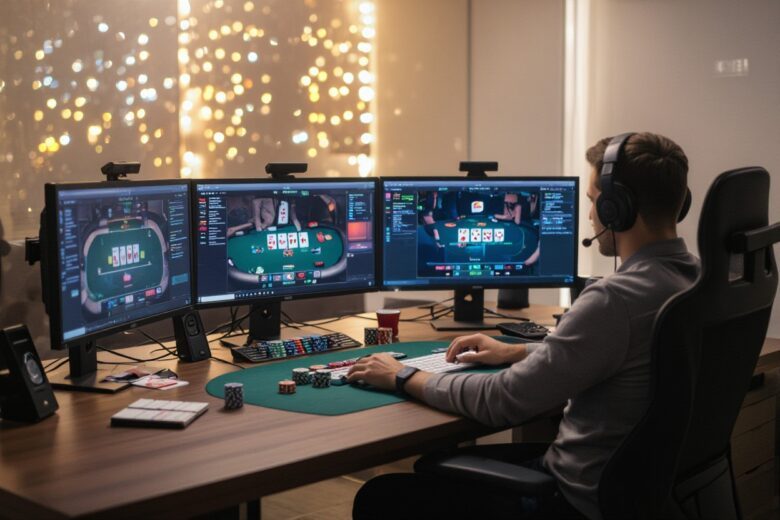Most online poker players experiment with multi-tabling to boost their profits, but it can quickly become overwhelming without proper strategy. When you play multiple tables simultaneously, it’s easy to lose focus, make costly mistakes, and decrease your overall efficiency. However, by implementing effective time management, understanding the importance of table selection, and using helpful software tools, you can maximize your winnings while maintaining a high level of gameplay. In this post, you’ll learn how to navigate the challenges and leverage the advantages of multi-tabling to elevate your poker sessions.
Mastering the Art of Multi-Tabling
Balancing multiple poker tables demands more than just quick decision-making; it requires strategic organization and smart tools to maintain sharpness throughout every session. Your ability to scan several screens simultaneously and prioritize the most profitable actions can increase your hourly rate significantly. Professional players often advocate for starting with just two or three tables, refining your rhythm before scaling up. Efficient multi-tabling hinges on streamlined focus combined with learned patterns from repeated play, allowing you to instinctively recognize profitable spots even amid complex, rapidly changing scenarios.
Setting Up Your Workspace for Optimal Focus
Design your setup to minimize distractions and enhance ergonomic comfort — think multiple monitors arranged to reduce head movement and lighting that prevents eye strain. A quality chair and desk, coupled with adjustable screen heights, help maintain alertness during lengthy sessions. Some pros even organize tables in a specific layout, such as grid or circular patterns, to quickly spot action without unnecessary shifting of gaze. Experiment to figure out what suits your style best, since a well-tuned physical environment directly impacts your mental stamina and decision speed.
Utilizing Software Tools to Enhance Efficiency
Leveraging specialized poker software can dramatically improve your multi-tabling performance. Programs like Table Ninja or PokerTracker offer customizable hotkeys, real-time stats, and automated bet sizing, speeding up routine actions. These tools provide invaluable hand histories that help identify patterns and leaks in your game, especially when juggling several tables simultaneously. Integration of HUDs (Heads-Up Displays) allows you to access opponents’ tendencies quickly, shaping smarter moves with just a glance.
Software tools not only accelerate your response time but also reduce cognitive load. For example, Table Ninja lets you set hotkeys for common bet sizes and folds, minimizing mouse clicks and cutting down reaction time by more than half. PokerTracker complements this with detailed opponent analytics, showing VPIP (Voluntarily Put Money In Pot) and aggression frequency right on each player’s avatar. This data-driven edge helps you quickly categorize opponents at every table, maintaining a winning strategy even during intense multi-table sessions. The combination of automation and analytics streamlines decision-making, transforming a handful of tables into a profitable multitasking operation.
Cognitive Load Management in Online Poker
Multi-tabling exponentially raises the demand on your mental processing. Balancing rapid hand reviews, bet sizing calculations, and opponent behavior analysis across several tables can overwhelm your cognitive capacity if not managed properly. Each table acts as a separate puzzle, and the combined complexity may lead to processing bottlenecks resulting in slower decisions or suboptimal plays. Recognizing these limits lets you implement methods to distribute mental effort effectively, helping you maintain consistent performance even during high-volume sessions.
Recognizing and Overcoming Decision Fatigue
Decision fatigue typically creeps in after intense, prolonged focus on multiple tables, degrading your ability to weigh options accurately. Signs like impulsive raises or missed value bets signal fatigue. You can counter this by scheduling short, strategic breaks every 45-60 minutes to reset your mental clarity. Additionally, simplifying decisions with pre-planned ranges and notes on opponents can reduce cognitive burden, sustaining sharper judgment as you push through extended gameplay.
Strategies for Focused Attention While Playing Multiple Tables
Optimizing concentration across tables demands deliberate tactics such as prioritizing active tables where action is imminent and pausing less dynamic ones. Visual cues like color-coded chips or table layouts help differentiate game states instantly. Employing software tools for alerts on specific hand scenarios or opponent tendencies directs your attention where it’s needed most. These approaches mitigate distractions and enhance real-time situational awareness.
Drilling down, spatial arrangement of tables on your screen greatly influences attention allocation—placing high-action or higher-stakes tables centrally boosts responsiveness. Combining auditory signals for key events with visual indicators reduces missed opportunities, letting your brain switch focus efficiently. Tracking your performance metrics across tables helps identify when cognitive overload begins affecting play, enabling timely adjustments. Embedding these layered strategies creates an environment where you can maintain precision and speed, even as the number of tables climbs.
Developing a Dynamic Playing Strategy
A flexible approach lets you handle the fast pace of multi-tabling effectively. Instead of sticking rigidly to one plan, you shift gears based on your stack sizes, table speeds, and opponent tendencies simultaneously. When you spot a passive player, you increase aggression aggressively exploit their mistakes, while pulling back on tables with tighter players to avoid overcommitting. This kind of balanced adaptability not only helps in managing risks but also in maximizing your gains across multiple games.
How to Adapt Your Game Across Different Tables
Every table has its unique rhythm and player profile, so you calibrate your actions accordingly. For example, at a turbo table with quick blind increases, you play more hands and prioritize accumulation, while at deep-stack cash games, patience and post-flop skills become paramount. Pay attention to bet sizing patterns and opening ranges, adjusting your aggression level dynamically per table. Leveraging software tools that display stats per table also enhances your ability to swiftly tune into emerging trends without losing focus.
Key Adjustments for Varying Opponent Styles
Adjust your strategy based on opponents’ tendencies to stay ahead. Versus loose-aggressive players, tighten your calling range and primarily trap with premium hands, using slowplays to extract maximum value. Against tight players, widen your opening range and increase bluffing frequency to steal pots uncontested. When facing passive opponents, raise the frequency of continuation bets and increase pressure post-flop to exploit their reluctance to fight back.
Working against a loose-aggressive (LAG) opponent, you should incorporate a polarized range, calling down only with top pairs or better while folding marginal holdings. Versus tight-conservative players, your value bets should be more straightforward, focusing on pot control to avoid costly bluffs. Widely recognized as one of the most effective multi-tabling adjustments, profiling each player’s tendencies enriches your decision matrix, allowing you to anticipate their moves better and respond with precision.
Evaluating Performance and Progress
Tracking your results beyond just wins and losses reveals patterns in your multi-tabling approach. Focusing on metrics like hands played per hour, average pot size, and VPIP (Voluntarily Put Money In Pot) helps identify where your efficiency peaks or drops. Consistent review of these statistics within poker tracking software highlights moments when cognitive overload may skew your decision-making, allowing you to adjust either the number of tables or your play style dynamically. Objective evaluation anchors your learning curve firmly in data rather than subjective recall.
Analyzing Session Data for Continuous Improvement
Session reviews using tools like PokerTracker or Hold’em Manager uncover tendencies you might overlook mid-play—such as increased fold rates on late streets or suboptimal bet sizing. You can pinpoint whether switching tables or focusing on fewer games during tougher beats improves outcomes. This granular insight into your session data facilitates targeted practice, enabling refinement in hand selection, timing, and opponent profiling, which ultimately accelerates skill acquisition and mental stamina during multi-tabling.
Setting Realistic Goals to Enhance Skill Development
Establish clear, measurable objectives tailored to your current ability and available playing time, like increasing hands played per hour by 10% over a month or decreasing unforced errors by tracking showdown losses. Breaking down your progress into manageable benchmarks keeps motivation high and prevents burnout. Aligning goals with specific aspects of multi-tabling, such as mastering optimal bet sizing or balancing aggression across four tables, ensures continuous personal growth and more consistent earnings.
Effective goal-setting involves defining short and long-term targets that are both challenging and attainable, creating a structured roadmap for improvement. For instance, if you identify from your data that your post-flop decision accuracy drops beyond three simultaneous tables, a goal could focus on enhancing concentration through meditation or reducing active tables until performance stabilizes. Combining quantitative goals, like a 15% reduction in timing errors, with qualitative aims, like better mental resilience under pressure, fosters comprehensive development tailored to the complexities unique to multi-tabling.
Building a Supportive Community
Surrounding yourself with like-minded multi-tablers can accelerate your learning curve and keep your motivation high. Collaborating on hand reviews and sharing software tips provides real-world insights that theoretical knowledge often misses. You might find fellow players who use different setups or strategies, which can challenge your approach and lead to stronger overall skills. Regular interaction creates a feedback loop that sharpens your decision-making and prevents the isolation that sometimes comes with remote online play.
Engaging with Other Multi-Tablers for Best Practices
Diving into conversations with experienced multi-tablers reveals nuanced techniques for efficient table management, such as timing your actions to reduce mental fatigue and leveraging hotkeys effectively. Peer exchange often highlights small details that separate average performance from winning sessions, like adjusting bet sizing according to table speed or balancing aggression across multiple tables. Learning directly from others’ success and failure stories sharpens your tactical edge and keeps you adaptive in evolving gameplay environments.
Participating in Forums and Study Groups
Online poker forums and study groups offer an invaluable space for exchanging strategies and discussing the latest software tools designed for multi-tabling. Engaging there exposes you to diverse viewpoints and fresh concepts, like optimizing HUD configurations or employing selective table reviews. Study groups promote discipline through scheduled sessions, fostering consistent practice and critical analysis of your play. Being part of these communities means you tap into collective expertise that elevates your game beyond what solo effort can achieve.
Forums such as TwoPlusTwo and PocketFives host extensive discussions where multi-tablers share detailed hand histories and analyze statistical trends across sessions. You can access curated resources including curated video tutorials, spreadsheets tracking your results, and threads on server-specific quirks. Study groups often utilize communication platforms like Discord or Slack for real-time collaboration, enabling you to ask questions, receive instant feedback, and participate in hand quizzes that sharpen your analytical skills. Joining these networks unlocks access to an ongoing support system geared toward continuous improvement in multi-tabling efficiency and profitability.
Summing up
Ultimately, mastering multi-tabling in online poker requires strategic focus and effective time management to maintain your efficiency. By implementing proper game selection, using software tools, and staying disciplined with your bankroll, you can enhance your decision-making across tables without becoming overwhelmed. Optimizing your setup and continually refining your skills will help you stay sharp and competitive, allowing you to maximize your potential earnings while minimizing unnecessary risks. Adapting these practices ensures you maintain control and perform consistently even when juggling multiple games simultaneously.




